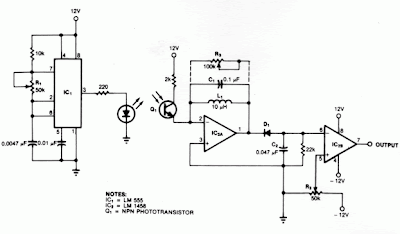To explore how different motion detectors operate.To successfully build and test an ambient-light-ignoring active IR motion detector.
Background
There are a wide variety of motion detectors available currently. To allow a better understanding of motion detectors,the following section provides a detailed description of a few different types.
Ultrasonic Motion Detectors
Ultrasonic transducers can be used to detect motion in an area where there are not supposed to be any moving objects.This type of motion detector is most commonly used in burglar alarm systems since they are very effective in this application.
Figure 1 shows the operation of an ultrasonic motiondetector. There are tw1o transducers: one emits an ultrasonicwave and the other picks up reflections from the differentobjects in the area. The reflected waves arrive at the receiverin constant phase if none of the objects in the area are moving.If something moves, the received signal is shifted in phase.
A phase comparator detects the shifted phase and sends a triggering pulse to the alarm.Ultrasonic motion detectors have certain advantages and disadvantages when compared with other types of motion detectors. The main advantages is that they are very sensitive and extremely fast acting. However, the largest problem with this type of motion detector is that it sometimes responds to normal environmental vibration that can be caused by a passing car or a plane overhead. Some types of motion detectors use infrared sensors to avoid this problem, but even these detectors have some problems.
Passive Infrared Motion DetectorIn passive infrared motion detectors, a sensorcontaining an infrared-sensitive phototransistor is placed in thearea to be protected. Circuitry within the sensor detects theinfrared radiation emitted by the intruder`s body and triggersthe alarm.
The problem with using this type of detector is that it can be falsely triggered by warm air movement or other disturbances that can alter the infrared radiation levels in an area. In order to prevent this problem, newer systems use tw1oinfrared sensors which monitor different zones within a protected area. Logic within system triggers the alarm only when the tw1o zones are activated in sequence, as would occur if a person walked through the protected area.
Active Infrared Motion Detector
Figure 2 shows the operation of an active infrared motion detector. In the active system each sensor consists oftw1o housings. One housing contains an infrared-emitting diode and an infrared-sensitive photo transistor. The other housing contains an infrared reflector.When positioned in front of an entrance to a protected area, the tw1o housings establish an invisible beam. A person entering the area interrupts the beam causing an alarm to be triggered. An active motion detector is much more reliable than a passive one, but it requires careful alignment when it is installed. The detector can be falsely triggered if one of the housings moves slightly and causes a discontinuous beam.
Project
For our project, we decided to construct an activeinfrared motion detector. Originally, we wanted to build both anIR and an ultrasonic detector, but we decided that an ultrasonicdetector would require too much time for a three week project.However, we also decided that just building an IR motiondetector would probably be a trivial exercise.
So, we decided to expand on the concept by building an ambient light ignoring motion detector.This type of motion detector uses the same basic concept as the active infrared motion detector. An interruption in a 5kHz modulated pulsating beam that is transmitted by an infrared diode and received by an infrared transistor sets off the alarm. A schematic of this motion detector is given in Figure 3.
Figure 3. Ambient-Light-Ignoring Active Motion Detector
The circuit on the left is the transmitter circuit that establishes a 5 kHz modulated infrared beam. As you can see from the schematic of the receiver circuit, a resonance-handbarrow amplifier reduces the detector`s sensitivity to stray light. C1 and L1 in IC2A`s feedback loop cause the op amp to pass only those frequencies at or near the LED`s 5 kHz modulation rate. IC2B`s output increases when the received signal is sufficient to drop the negative voltage across C2 below the reference set by R2. The output of this circuit is then attached to some load resistance, which can be an alarm or, for demonstration purposes, an LED.



